[ExpertPhotography is supported by readers. Product links on ExpertPhotography are referral links. If you use one of these and buy something, we make a little bit of money. Need more info? See how it all works here.]
How Ansel Adams Creates Art
50% of the Creative Process Occurred in the Dark Room
Ansel Adams is well known for spending a whole day in the darkroom, just to produce one print. He and Fred Archer formulated the Zone system. The technique is a systematic method that helped photographers to determine the optimal film exposure and development. He would paint onto the enlarger the areas of the photo he thought should be darker or lighter than others. His ability to find perfection in the darkroom coupled with his work behind a camera has produced some of the greatest landscape photography ever made. The lesson here is that processing is just as important as the photo-taking process, and shouldn’t be looked down upon as a lesser art form.
His Best Work Uses a Dropped Horizon
During his earlier work in the 1920s and 30s, Adams would place the horizon very high in the frame, giving favour to the landscape below. It’s widely regarded that his best work game in the decades to come, would often favour a much higher horizon. Placing the horizon so high in the frame helped the viewer to realise the scale of the image, in comparison to the sky that surrounded it. You can read more about horizon placement here.
He Was So In Tune With His Equipment, Taking Photos Became Instinctive
Arguably his most famous photograph, Moonrise Over Hernandez was taken within a few seconds of pulling his car over to the side of the road he was driving along. With the sunlight rapidly moving away, and not enough time to find his light reader, Ansel Adams very quickly calculated the exposure for the photo, without any tools but his mind. He was so in tune with his equipment, the process became instinctive to him when it mattered the most. As he went to capture a second ‘safety’ photo after the first, the sun had gone from the gravestones in the foreground, and the moment had gone with it. If you understand your camera and your exposure, taking photos becomes instinctive.
Ansel Adams Went to Great Lengths to Capture his Photos
For Ansel Adams, this meant climbing mountains, trekking for hours at a time. He would often leave before dawn, and arrive home after dusk, because he knew the importance of finding the right place to stand. A common problem that many of us face, is that we simply don’t have the same kind of commitment to taking photos.
He Was a Very Small Part of The Frame
The first thing most people notice about Adam’s photography is the sheer scale of the images. The fact that man seems so insignificant in comparison. They’re often of the great outdoors, which puts man into perspective. He wanted people to understand the world, through his images. That we live in a world that exists in a larger world. His images seem to have almost completely detached a human attachment, and I think that’s part of the reason that they’re so great. It’s encouraged our focus onto the parts of the image that he wants us to see.
He Always Knew Before He Took The Photo
Ansel Adams often only took two of the same photo, one extra for safety, in case of scratches or marks in the dark room. Ask yourself, how many photos do you take of the same scene? Lots, right? He always knew the shutter speed and aperture for the photo he was going to take. He could tell just by looking at the frame, what settings he would have to use to make certain areas stand out more than others, and whether he needed a filter or not. If you think more before you shoot, you can probably work this out too.
Ansel Adams Communicated Feelings, not Images
When Adams took a photo, he didn’t just capture a scene, he captured a feeling. I challenge anyone interested in photography to view the works of Ansel Adams and not feel something. It is this thought process behind his images which make them so powerful. Whether you felt the same as he did, or even understood his message, is not the important factor here. He created these images knowing exactly what he wanted to portray, before he pressed the shutter. That’s something I think we can all learn from. How many of us just pick up the camera and shoot without thinking? We live in a digital world of instant gratification, and I think that’s caused us to think less as photographers.
His Purpose for Taking Photos Was Much Greater than for Art
The great French photographer Henri Cartier-Bresson made the well-known comment that: This was a criticism to the fact that Adams focused so much on capturing images of the world, when there were arguably more important factors at stake. Adams didn’t see it this way though, as a very strong conservationist. He fought hard to lobby congress to create more national parks and was successful with Kings Canyon National Park. After his death in 1984, an area of national park was named The Ansel Adams Wilderness, and a mount was even named after him, Mount Ansel Adams. His purpose is clear in his photos and his legacy. You can see the drive behind his images. What’s your purpose?
Ansel Adams Didn’t Find Financial Success Until his 60s
It wasn’t until Adams was in his 60s that he finally reached commercial success as a fine art photographer. Up until then, he would work as a commercial photographer when he had to, as a means to earn money to support his family. While still focusing on fine art photography, and incorporating it into commercial photography where possible. Shooting fine art photography was the passion, but as a creative, the multi-million dollar business didn’t come naturally. It was only when he met his business partner that things started to change. He had always been a phenomenally successful fine art photographer, with wide critical acclaim, but the lesson here is that we shouldn’t try to manage every aspect of photography. If you need help transforming your business, by changing your position in the market, then you should seek it. Adam’s highest value print sold at auction is Moonrise Over Hernandez, which sold at Sotheby’s for $609,600 in 2006.
Ansel Adams Never Followed ‘Rules’ of Photography
I feel this is a nice quote from Ansel Adams to end on. For Adams, there was a clear purpose behind his photography. You can see the hours of work he put in to find the right location and time to capture the perfect photo. Then the hours he spent meticulously developing his photos in the darkroom. Ansel Adams was a man who instinctively knew good photography, from decades of practice and a life in the art world. If you ever wish to produce a standard of work even remotely close to his, you need to step away from your computer, get out there, and start taking photos.


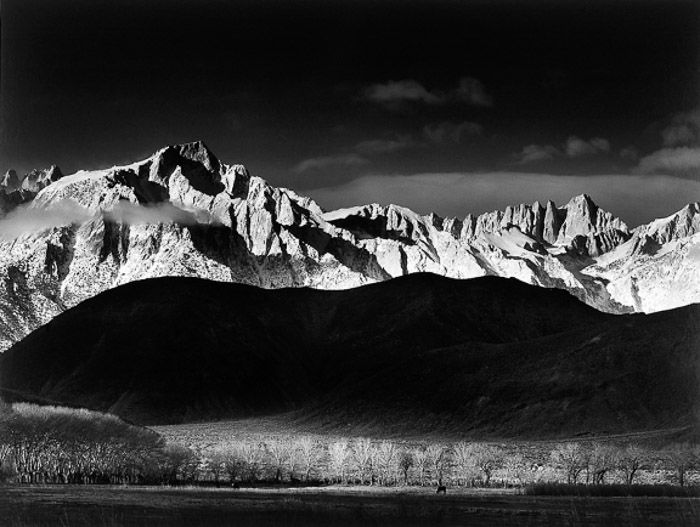
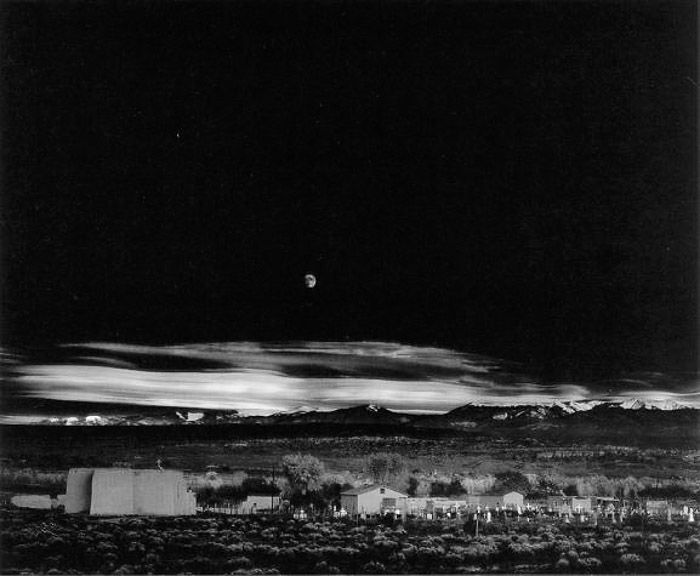
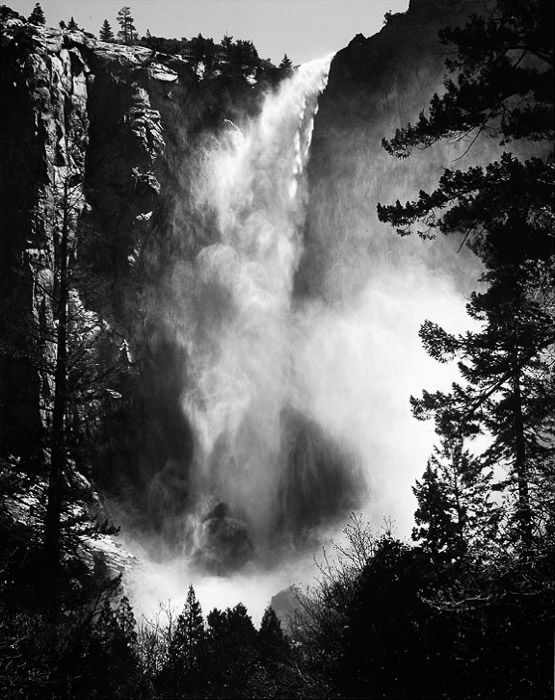
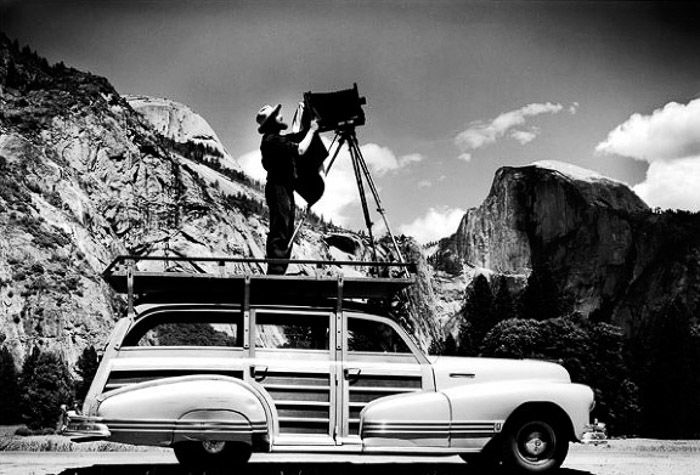
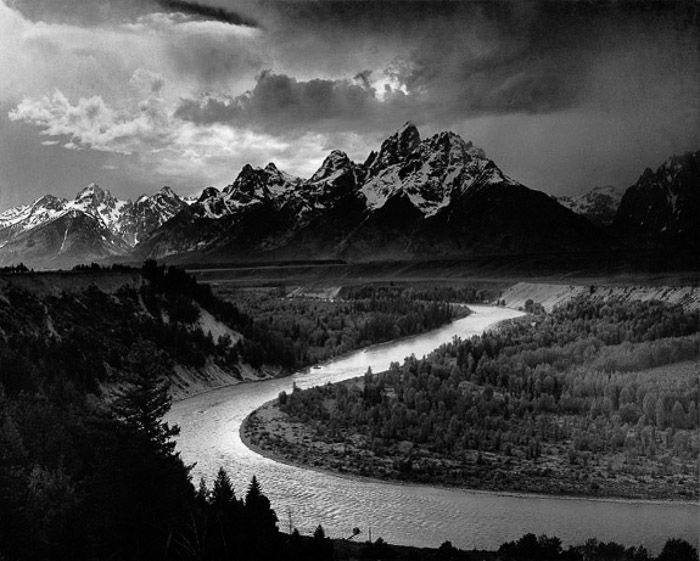
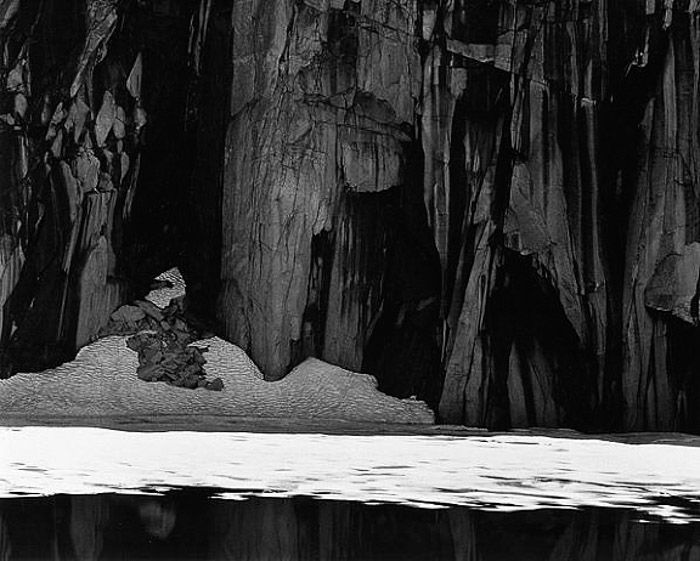


title: “10 Important Photography Lessons From Ansel Adams” ShowToc: true date: “2023-02-14” author: “Tracey Payne”
[ExpertPhotography is supported by readers. Product links on ExpertPhotography are referral links. If you use one of these and buy something, we make a little bit of money. Need more info? See how it all works here.]
How Ansel Adams Creates Art
50% of the Creative Process Occurred in the Dark Room
Ansel Adams is well known for spending a whole day in the darkroom, just to produce one print. He and Fred Archer formulated the Zone system. The technique is a systematic method that helped photographers to determine the optimal film exposure and development. He would paint onto the enlarger the areas of the photo he thought should be darker or lighter than others. His ability to find perfection in the darkroom coupled with his work behind a camera has produced some of the greatest landscape photography ever made. The lesson here is that processing is just as important as the photo-taking process, and shouldn’t be looked down upon as a lesser art form.
His Best Work Uses a Dropped Horizon
During his earlier work in the 1920s and 30s, Adams would place the horizon very high in the frame, giving favour to the landscape below. It’s widely regarded that his best work game in the decades to come, would often favour a much higher horizon. Placing the horizon so high in the frame helped the viewer to realise the scale of the image, in comparison to the sky that surrounded it. You can read more about horizon placement here.
He Was So In Tune With His Equipment, Taking Photos Became Instinctive
Arguably his most famous photograph, Moonrise Over Hernandez was taken within a few seconds of pulling his car over to the side of the road he was driving along. With the sunlight rapidly moving away, and not enough time to find his light reader, Ansel Adams very quickly calculated the exposure for the photo, without any tools but his mind. He was so in tune with his equipment, the process became instinctive to him when it mattered the most. As he went to capture a second ‘safety’ photo after the first, the sun had gone from the gravestones in the foreground, and the moment had gone with it. If you understand your camera and your exposure, taking photos becomes instinctive.
Ansel Adams Went to Great Lengths to Capture his Photos
For Ansel Adams, this meant climbing mountains, trekking for hours at a time. He would often leave before dawn, and arrive home after dusk, because he knew the importance of finding the right place to stand. A common problem that many of us face, is that we simply don’t have the same kind of commitment to taking photos.
He Was a Very Small Part of The Frame
The first thing most people notice about Adam’s photography is the sheer scale of the images. The fact that man seems so insignificant in comparison. They’re often of the great outdoors, which puts man into perspective. He wanted people to understand the world, through his images. That we live in a world that exists in a larger world. His images seem to have almost completely detached a human attachment, and I think that’s part of the reason that they’re so great. It’s encouraged our focus onto the parts of the image that he wants us to see.
He Always Knew Before He Took The Photo
Ansel Adams often only took two of the same photo, one extra for safety, in case of scratches or marks in the dark room. Ask yourself, how many photos do you take of the same scene? Lots, right? He always knew the shutter speed and aperture for the photo he was going to take. He could tell just by looking at the frame, what settings he would have to use to make certain areas stand out more than others, and whether he needed a filter or not. If you think more before you shoot, you can probably work this out too.
Ansel Adams Communicated Feelings, not Images
When Adams took a photo, he didn’t just capture a scene, he captured a feeling. I challenge anyone interested in photography to view the works of Ansel Adams and not feel something. It is this thought process behind his images which make them so powerful. Whether you felt the same as he did, or even understood his message, is not the important factor here. He created these images knowing exactly what he wanted to portray, before he pressed the shutter. That’s something I think we can all learn from. How many of us just pick up the camera and shoot without thinking? We live in a digital world of instant gratification, and I think that’s caused us to think less as photographers.
His Purpose for Taking Photos Was Much Greater than for Art
The great French photographer Henri Cartier-Bresson made the well-known comment that: This was a criticism to the fact that Adams focused so much on capturing images of the world, when there were arguably more important factors at stake. Adams didn’t see it this way though, as a very strong conservationist. He fought hard to lobby congress to create more national parks and was successful with Kings Canyon National Park. After his death in 1984, an area of national park was named The Ansel Adams Wilderness, and a mount was even named after him, Mount Ansel Adams. His purpose is clear in his photos and his legacy. You can see the drive behind his images. What’s your purpose?
Ansel Adams Didn’t Find Financial Success Until his 60s
It wasn’t until Adams was in his 60s that he finally reached commercial success as a fine art photographer. Up until then, he would work as a commercial photographer when he had to, as a means to earn money to support his family. While still focusing on fine art photography, and incorporating it into commercial photography where possible. Shooting fine art photography was the passion, but as a creative, the multi-million dollar business didn’t come naturally. It was only when he met his business partner that things started to change. He had always been a phenomenally successful fine art photographer, with wide critical acclaim, but the lesson here is that we shouldn’t try to manage every aspect of photography. If you need help transforming your business, by changing your position in the market, then you should seek it. Adam’s highest value print sold at auction is Moonrise Over Hernandez, which sold at Sotheby’s for $609,600 in 2006.
Ansel Adams Never Followed ‘Rules’ of Photography
I feel this is a nice quote from Ansel Adams to end on. For Adams, there was a clear purpose behind his photography. You can see the hours of work he put in to find the right location and time to capture the perfect photo. Then the hours he spent meticulously developing his photos in the darkroom. Ansel Adams was a man who instinctively knew good photography, from decades of practice and a life in the art world. If you ever wish to produce a standard of work even remotely close to his, you need to step away from your computer, get out there, and start taking photos.









